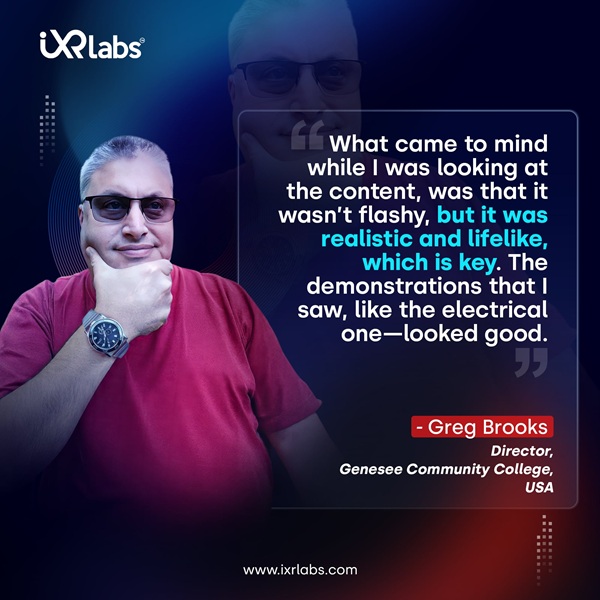How VR Makes Synchronous Machines Easier to Understand

For decades, electrical engineering students have struggled with one persistent challenge—understanding synchronous machines.
These powerful motors and generators play a crucial role in power generation, industrial automation, and grid synchronization. But ask any student, and they'll likely tell you the same thing: it’s hard to grasp how they actually work.
Why?
Because most universities still rely on 2D diagrams, outdated textbooks, and underutilized lab setups. Concepts like electromagnetic field interaction, rotor-stator alignment, and excitation systems remain abstract in traditional classrooms.
That’s where virtual reality (VR) is changing everything. By merging interactive simulations with real-world physics, virtual reality in electrical engineering is helping students actually see, manipulate, and understand how synchronous machines operate.
What Are Synchronous Machines?
Let’s start with the basics. Synchronous machines are AC machines that run at constant speed, determined by the frequency of the supply voltage. There are two types:
● Synchronous Generators (Alternators): Convert mechanical energy into electrical energy.
● Synchronous Motors: Convert electrical energy into mechanical energy.
What makes them unique?
Unlike induction motors, synchronous motors rotate at exact synchronous speed, meaning their rotor locks in with the stator’s rotating magnetic field.
Applications include:
● Power plants (alternators)
● Industries needing constant-speed motors
● Grid-tied renewable energy systems
Why Students Struggle with Synchronous Machines
Despite their importance, synchronous machines are one of the most challenging topics in electrical engineering education.
The common issues:
● Abstract Concepts: Flux linkage, torque angle, and power factor correction—these aren’t easy to visualize.
● Limited Lab Access: Physical machines are expensive, bulky, and require safety precautions.
● 2D Limitations: Textbooks and slides can’t show dynamic electromagnetic interactions.
● Passive Learning: Lack of interactivity leads to poor retention.
Educators know the theory matters. But students need experience, not just explanation.
Virtual Reality in Electrical Engineering: A Game Changer
Virtual reality allows electrical engineering departments to bridge the gap between theory and application. It transforms passive learning into an immersive experience.

With VR electrical machine simulation, students can:
● Walk around a virtual synchronous machine
● See how the rotor and stator interact
● Observe field excitation in real-time
● Simulate load variations and power angle shifts
It’s not just visually engaging—it’s educationally transformative.
How VR Helps in Understanding Synchronous Motors
Let’s break down how VR enhances understanding of synchronous motors specifically.
1. Real-Time Rotor-Stator Interaction
Students can rotate the machine’s parts, examine rotor poles, and align them with the rotating magnetic field.
This eliminates the abstractness of “synchronism”—they actually see it happening.
2. Field Excitation Control
A virtual slider lets learners change excitation current and instantly observe:
● Torque development
● Power factor variation
● Effects on speed and synchronism
3. Load Response Simulation
How does a synchronous motor behave under varying loads?
VR modules show:
● Load angle increases
● Torque behavior
● Pull-out torque conditions
All without risking a short circuit or motor failure.
4. Fault Analysis
VR-based fault simulations help students understand:
● Overexcitation and underexcitation
● Armature reaction
● System instability during synchronization loss
Features of a VR Module for Electrical Machines
A powerful VR electrical machines module usually includes:
| Feature | Description |
|---|---|
| 360° Machine View | Students can walk around the machine virtually and zoom in on components |
| Animated Magnetic Fields | Visualize flux paths and waveforms in real-time |
| Interactive Panels | Switch rotor types, set load conditions, adjust excitation levels interactively |
| Assessment Mode | Mini-tests and performance tracking for personalized learning and feedback |
| Multilingual Interface | Ensures accessibility for diverse student populations across regions |
Institutional Benefits of VR in Electrical Machine Education
For universities, adopting VR technology doesn’t just enhance learning—it also:
● Reduces cost: No need for maintaining expensive synchronous machine setups.
● Supports remote learning: VR labs can be accessed via VR headsets or even regular laptops.
● Standardizes learning: Every student gets equal access to high-quality, hands-on experience.
● Encourages innovation: Universities can build their own scenarios and projects.
In short, it’s a future-proof investment in engineering education
VR in Electrical Engineering Labs: The Future Is Now
It’s not just synchronous machines. Universities are already using VR to teach transformers, induction motors, circuit breakers, and power systems.
Here’s how a complete electrical machine in a VR suite can be structured:
| Machine Type | VR Experience Offered |
|---|---|
| Synchronous Motors | Rotor-stator interaction, load variation, excitation control |
| Synchronous Generators | Voltage regulation, AVR control, waveform analysis |
| Induction Motors | Slip simulation, torque-speed curve |
| Transformers | Magnetic coupling, losses, tap changing |
| Circuit Breakers | Arc simulation, relay action |
Final Thoughts: The VR Advantage in Teaching Synchronous Machines
Synchronous machines are central to electrical engineering—but they don’t have to remain mysterious.
Thanks to virtual reality in electrical engineering, students can:
● See what they’re learning
● Interact with real-world systems
● Understand deeply and remember longer
As universities look for more practical, scalable, and engaging teaching methods, VR stands out as not just a good solution—but the best one for the next generation of electrical engineers.

-min.png)
-min.png)

.png)